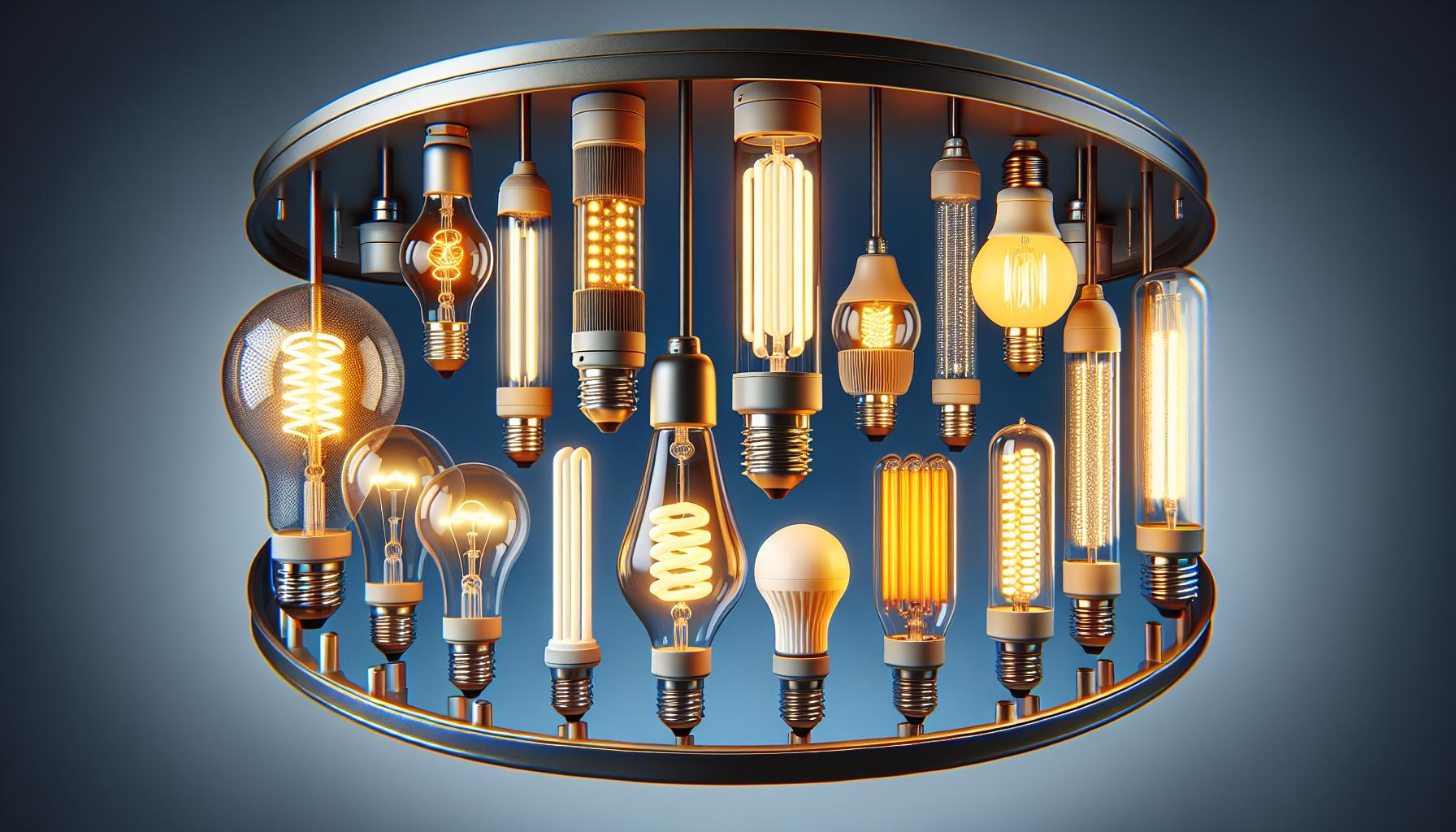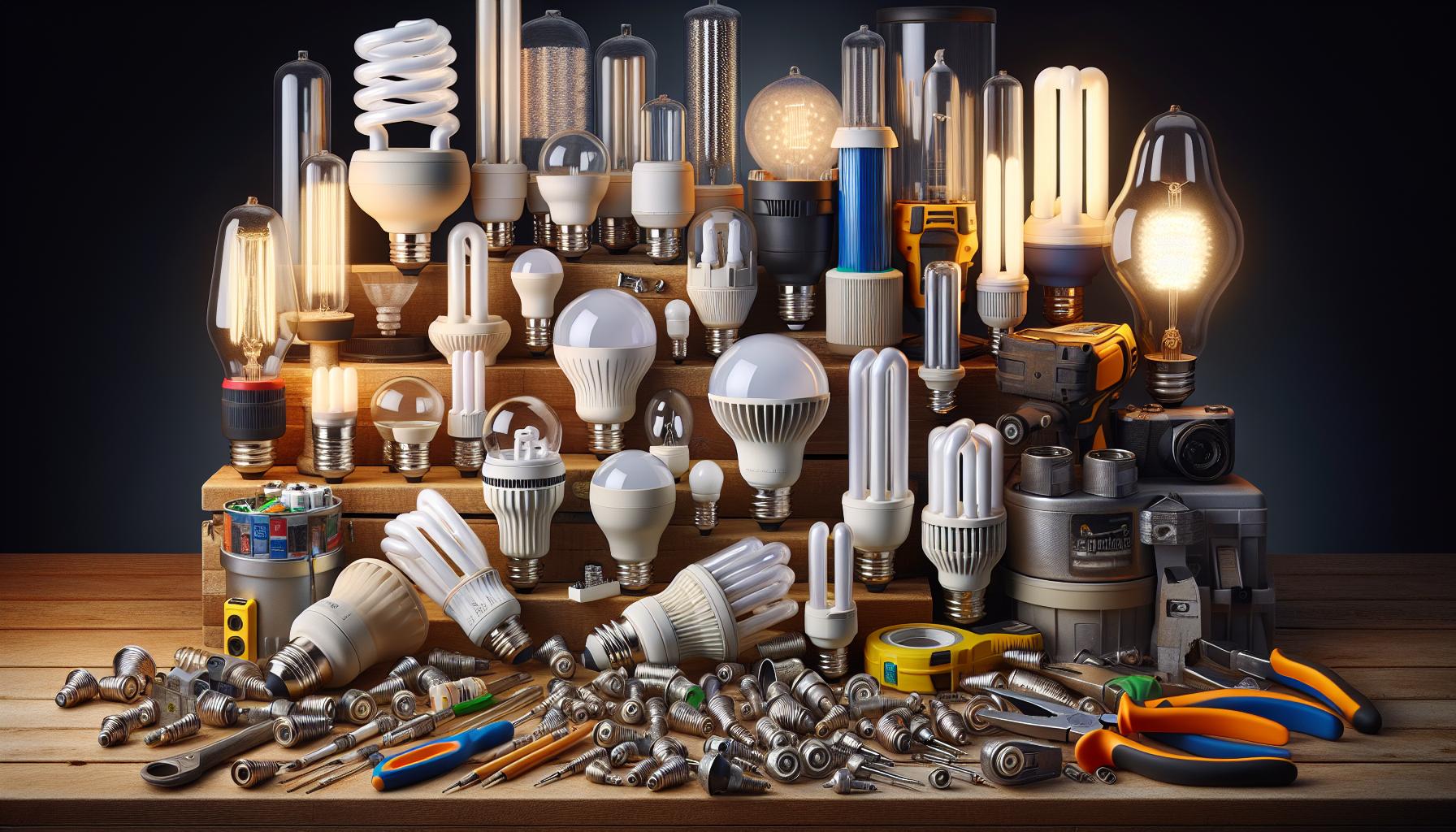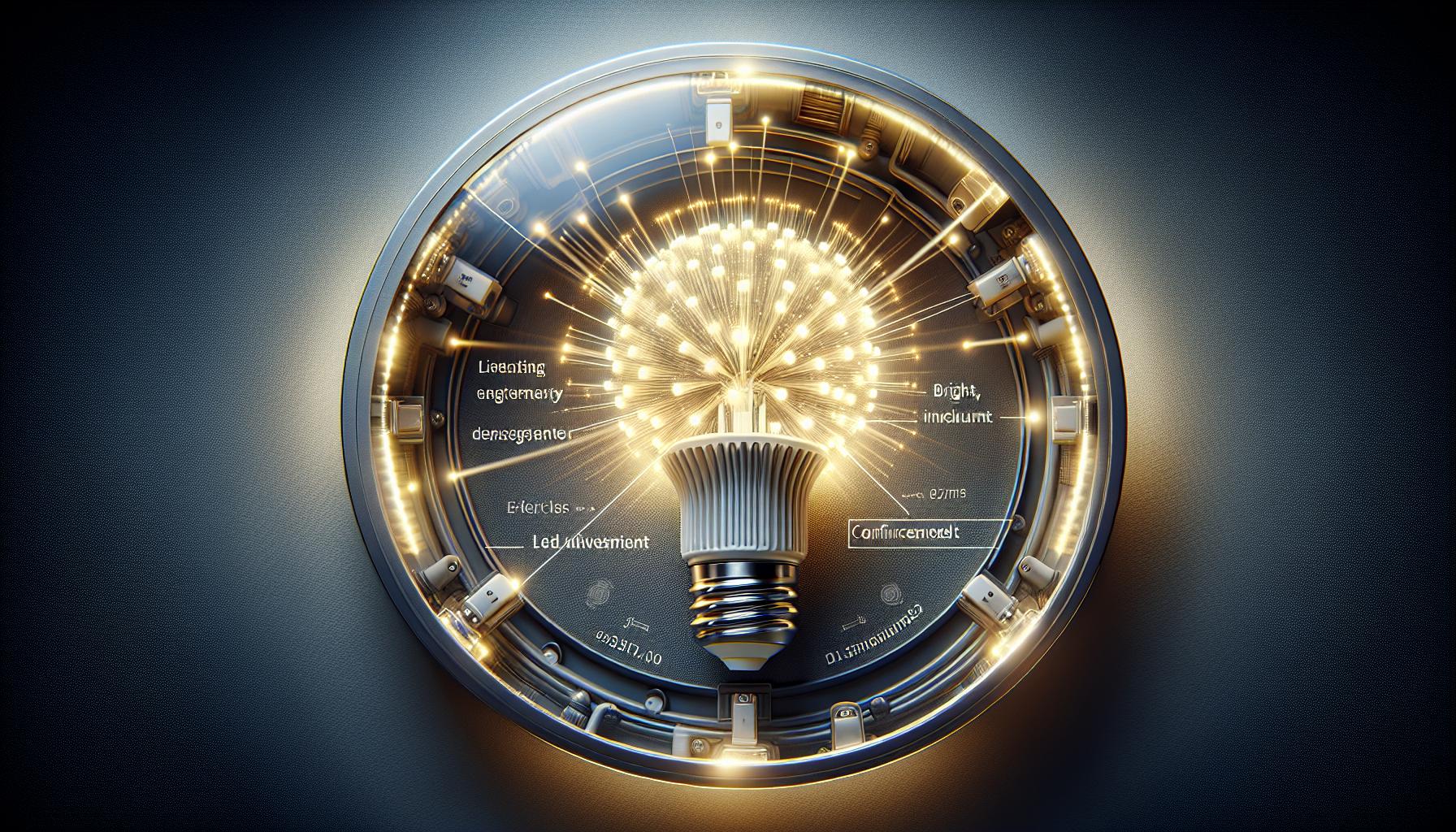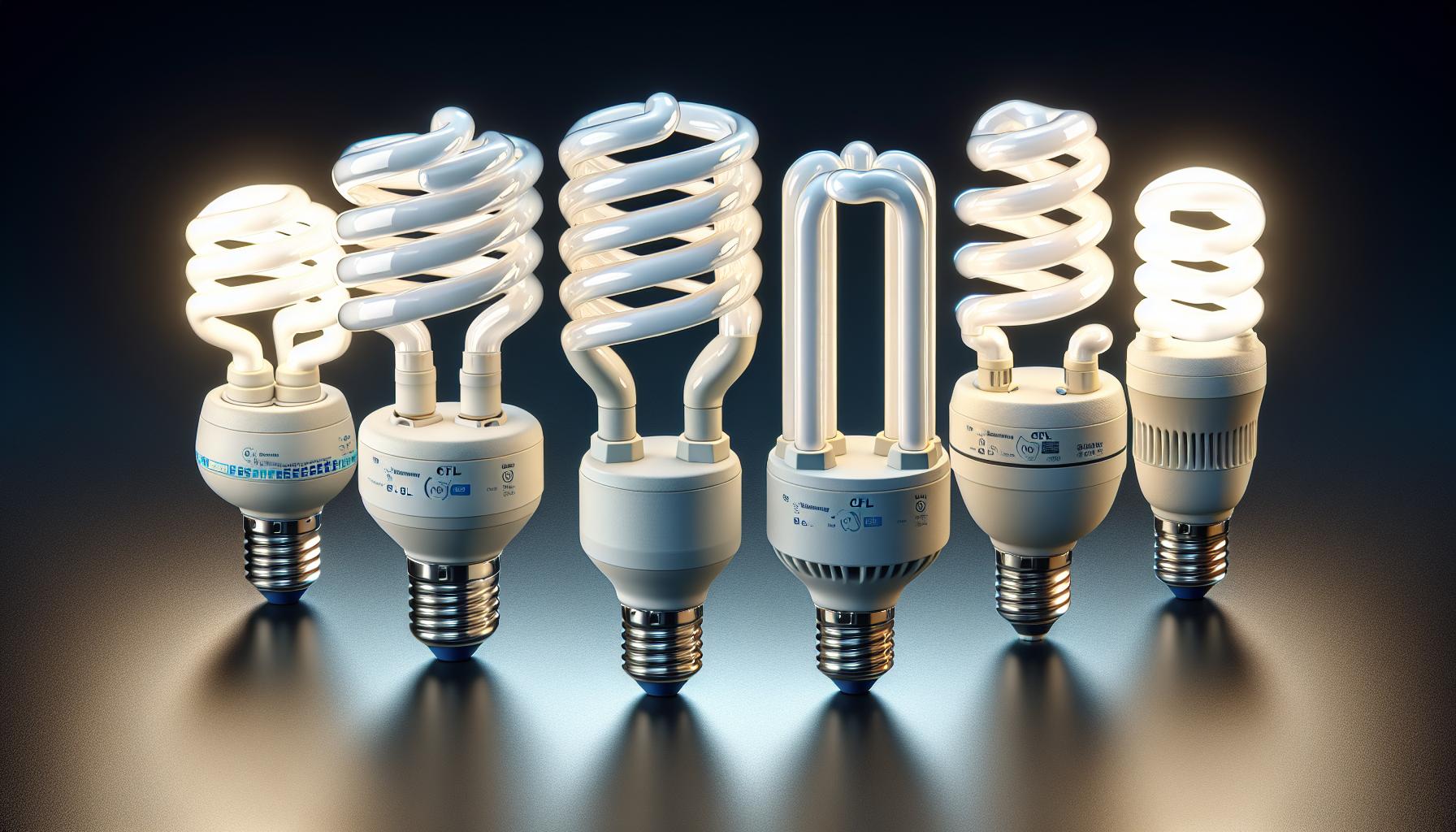Ever been stumped by the caution label on a light bulb package, warning against using it in an enclosed fixture? You’re not alone. Understanding which bulbs are safe and efficient for these fixtures can be like navigating a maze in the dark. But don’t worry, you’re about to shed some light on this perplexing subject.
Choosing the right bulb for an enclosed fixture is crucial, not just for the lifespan of the bulb, but also for your safety. Some bulbs are designed to handle the heat, while others could bid farewell much sooner than you’d like. So, let’s dive in and illuminate the best options for your cozy, enclosed spaces.
Why are some light bulbs not suitable for enclosed fixtures?
Light bulbs vary widely in terms of their design and the amount of heat they generate. One of the most important concerns when using an enclosed fixture is heat dissipation—or, more specifically, the lack thereof. In an enclosed space, heat cannot escape as easily, leading to higher temperatures that can shorten bulb life or pose a fire hazard.
Incandescent bulbs, for example, are notorious for producing a great amount of heat due to their inefficient conversion of electrical energy into light—most of it ends up as heat. This heat buildup can damage the fixture and the wiring. It’s not just the potential for overheating; the intense heat also diminishes the bulb’s lifespan.
On the other hand, CFL bulbs (compact fluorescent lamps) contain a small amount of mercury, which poses a risk if the bulb is damaged due to excessive heat in an enclosed fixture. Additionally, CFLs tend to perform poorly in high-temperature environments which can cause them to fail prematurely or not work as efficiently.
LED bulbs are often marketed as being suitable for enclosed fixtures due to their lower operating temperatures. However, not all LED bulbs are designed for the limited airflow of enclosed spaces. Some might have electronics that are sensitive to heat, which can lead to component failure. It’s critical to check the packaging or manufacturer’s information to ensure that an LED bulb is specifically rated for enclosed fixtures.
It’s also worth considering that different fixtures are designed with certain bulb types in mind. Using a bulb that generates too much heat or isn’t designed for the specific conditions of an enclosed fixture could void warranties and could even be against local building codes. It’s always best to check the fixture’s rating and follow manufacturer guidelines for suitable bulb types.
- Incandescent bulbs produce a lot of heat; not ideal for enclosed fixtures
- CFLs contain mercury and perform poorly in heat, posing risks
- Not all LEDs are suitable for enclosed fixtures—look for specific ratings
- Matching the right bulb to the fixture is essential for safety and performance
By keeping these considerations in mind, you’ll be able to select a light bulb that not only shines bright but also operates safely and efficiently within your enclosed fixtures. Always prioritize safety and longevity when choosing the light that’s right for your space.
Understanding the heat generated by light bulbs
When tackling DIY home projects, having the right lighting is key. You not only want your space to be well-lit, but also safe and efficient. That’s where understanding light bulb heat output becomes indispensable. Different bulbs emit varying amounts of heat, which is especially important when it comes to enclosed fixtures.
Incandescent bulbs are notorious heat generators. They work by heating a filament to a temperature that produces light. It’s that heated filament that pumps out a substantial amount of heat, more so than the light, which you’ve likely noticed if you’ve ever touched a bulb that’s been on for a while.
Imagine a summer day trapped inside a car with windows rolled up – that’s similar to the conditions inside an enclosed fixture. With insufficient airflow, heat can build up quickly, leading to several issues:
- Shortened Bulb Life
- Potential Damage to Fixture and Wiring
- Increased Fire Hazard
CFLs (compact fluorescent lamps) function by driving electric current through a tube containing argon and a small amount of mercury vapor. These also produce a considerable amount of heat. Although less than their incandescent cousins, it’s enough to affect their efficiency and lifespan in an enclosed fixture.
LEDs (light-emitting diodes), on the other hand, are much cooler. They bring light by moving electrons through a semiconductor. However, while most LEDs are cooler, they’re not immune to the effects of heat. High temperatures can compromise their internal components, leading to decreased light output and failure.
« What Is Halogen Light Bulbs? Uncover Their Bright Advantages & Uses
Why Is a Light Bulb Important? Unveil Its Surprising Role in Safety & Comfort »
The Heat Output of Different Bulb Types
| Bulb Type | Heat Emission |
|---|---|
| Incandescent | High |
| CFL | Moderate |
| LED | Low to Moderate |
Remember, always cross-check the bulb you’re eyeing for that cozy little nook against the manufacturer’s recommendations for enclosed fixtures. It might not always be clear-cut, so when in doubt, contacting the manufacturer or a lighting professional can shed some light on the right choice for your DIY lighting project.
Types of light bulbs that can be used in enclosed fixtures
When you’re planning your next home DIY project, choosing the right light bulb for enclosed fixtures is crucial. The idea is to find bulbs that deliver both efficiency and safety, minimizing the risks that come with high heat output. Let’s shed some light on the types that are suitable.
LED Bulbs: Your safest bet for enclosed fixtures is LED bulbs. Due to their low heat emission, they’re a popular choice. They come with advanced technology that not only keeps the bulb cool but also offers longer life spans and improved energy efficiency. Many LED bulbs are specifically designed to be used in enclosed spaces, so always check for that detail on the packaging.
Fluorescent Bulbs: While not as ideal as LEDs, fluorescent bulbs, including CFLs, can be used in enclosed fixtures as long as they are labeled accordingly. Since these bulbs emit less heat than incandescent bulbs, they’re a suitable albeit not perfect option. Ensure that you stick to wattage recommendations to avoid overheating.
Halogen Bulbs: These are less common for enclosed fixtures due to their high heat output. However, some halogen bulbs are engineered to be safe in enclosed spaces. If you opt for halogens, it’s critical to ensure they are designed for such use and follow the fixture’s wattage guidelines meticulously.
Incandescent Bulbs: Traditional incandescent bulbs are typically not recommended for enclosed fixtures because they generate a lot of heat. However, there are now some that are designed to handle the heat buildup in enclosed environments. Look for options that are specifically meant for this purpose to prevent hazards.
Key Considerations for Enclosed Fixture Bulbs:
- Always check the manufacturer’s recommendations
- Pay attention to the bulb’s heat output
- Look for bulbs marked as suitable for enclosed fixtures
Remember, each light bulb type comes with its own set of pros and cons. You’ll need to weigh these against your specific needs for brightness, energy efficiency, and fixture design. Whether it’s a cozy nook or a statement lighting piece, making the right choice now will save you both time and trouble in your upcoming projects.
1. LED bulbs
When it comes to lighting up your home, LED (Light Emitting Diode) bulbs have taken the spotlight for good reason. They’re a top pick for enclosed fixtures, thanks to their lower heat output and impressive longevity. So, let’s shed some light on why you might lean towards LEDs.
First up, energy efficiency is your gateway to saving dollars in the long run. LEDs use about 75% less energy than traditional incandescent bulbs, which means less strain on your wallet over time. Plus, their cool operation is a perfect match for enclosed spaces where heat buildup could be a concern. You don’t want to play with fire, and with LEDs, you pretty much don’t have to.
Let’s talk lifespan. These bulbs can last an astounding 15-20 years under normal usage conditions. That’s a long-term relationship with your light fixture we’re talking about. And we all know, replacing bulbs in those hard-to-reach fixtures is a chore best avoided.
Here’s a quick snapshot of LED benefits within enclosed fixtures:
- Lower heat output
- Reduced energy usage
- Longer lifespan
- Minimal maintenance
Keep in mind, the design of LED bulbs often incorporates heat sinks that help dissipate heat away from the light source. This design feature is crucial for their performance in enclosed environments. Moreover, LED technology has progressed to offer you a variety of color temperatures and brightness levels. Whether you’re setting the mood with warm, soft lighting or needing that daylight feel for task work, there’s an LED for that.
Be sure to check for certifications such as Energy Star or the DLC (DesignLights Consortium) when picking out LEDs. These endorsements help you to home in on quality options that have been tested and verified for efficiency and performance. Remember, the right bulb not only illuminates your space but also contributes to a comfortable, safe home environment. With LEDs, both your love for DIY and your passion for smart, energy-efficient lighting come together seamlessly.
2. CFL bulbs
You’ve most likely come across CFL bulbs, or compact fluorescent lamps, which are another choice for your enclosed fixtures. These bulbs offer a balanced mix of energy efficiency and longevity, though not as impressive as their LED counterparts.
CFL bulbs function best when they’re allowed to reach full operating temperature. The enclosed fixture may impact this process, slightly reducing their efficiency and lifespan due to restricted airflow. Nevertheless, they might be the right fit for you if you’re looking for a cost-effective option that’s better than the old incandescents.
CFLs have been mainstream for years, and you’ve probably used them for your various home DIY lighting projects. You already know they use about 70-75% less energy and last about six times longer than traditional incandescent bulbs. This means ample savings over the bulb’s lifetime. Here’s how CFLs measure up in energy savings:
| Bulb Type | Energy Use | Life Expectancy |
|---|---|---|
| Incandescent | 60 watts | 1,200 hours |
| CFL | 15 watts | 8,000 hours |
Another bonus: they come in a variety of shapes and wattages, fitting nicely with your various home aesthetics and lighting needs.
When choosing CFLs for your enclosed fixtures, remember to check the packaging. Manufacturers often indicate if the bulb is suitable for such environments. If it’s not clearly stated, caution dictates you look for another bulb type or consult with a professional to avoid overheating issues.
Your passion for home DIY means you appreciate ease of use and installation. CFLs are mostly user-friendly; however, unlike LEDs, they do contain a small amount of mercury, which requires careful disposal. Your environmental consciousness will lead you to recycle them properly; good lighting shouldn’t come at the expense of the planet.
Sprucing up your home’s lighting can enlighten every nook and cranny, creating the perfect ambiance. With CFLs in the mix, you can achieve that warm or cool white light for your enclosed fixtures that’s just perfect for a cozy night in or a productive day at your workbench.
3. Halogen bulbs
If you’re considering halogen bulbs for your enclosed fixtures, there are a few things you’ll want to keep in mind. These bulbs are a step up from traditional incandescent bulbs in terms of efficiency, but they’re not quite in the same league as CFLs or LEDs.
Halogen bulbs are known for their brightness and crisp, white light, which makes them an attractive option for spaces that require sharp illumination. Perfect for task lighting or highlighting artwork, halogen bulbs give you that natural daylight feel indoors. Plus, their compact size means they can fit neatly into a variety of enclosed fixtures without any hassle.
One of the advantages of using halogen bulbs is their excellent color rendering index (CRI), often clocking in at a near-perfect score. This means colors appear true to life under their glow, an essential feature for any space where the aesthetic is key. Imagine refining your latest DIY project under the accurate and reliable light of a halogen bulb – it’s a game changer.
However, halogen bulbs do produce more heat than CFLs or LEDs. It’s important to ensure that your enclosed fixtures are rated to handle the higher temperatures halogen bulbs can emit. Always check the fixture’s specifications against the bulb’s heat output to avoid potential hazards.
In terms of energy efficiency, halogen bulbs are about 20-30% more efficient than traditional incandescent bulbs but don’t quite reach the energy-saving levels of their CFL and LED counterparts. Here’s a quick comparison:
| Bulb Type | Energy Efficiency Improvement |
|---|---|
| Halogen | 20-30% |
| CFL | 70-75% |
| LED | 75-80% |
When it comes to lifespan, halogen bulbs typically outshine incandescents. They can last two to three times longer than a standard incandescent bulb. Still, this is shorter than the lifespan of both CFL and LED bulbs, which means you’ll be replacing them more frequently than you would with LEDs.
4. Incandescent bulbs
When you think about traditional lighting, incandescent bulbs probably come to mind. These classics have been lighting homes for more than a century, and they’re still commonly used in many light fixtures today, including enclosed ones. Even with the emergence of newer, more energy-efficient bulbs, some of you might find the warm glow of an incandescent bulb irresistible for certain spaces.
Incandescents work well in enclosed fixtures because they’re designed to handle a range of temperatures. But before you screw one into your decorative sconce or ceiling fixture, there are a few things to consider. While they might ooze that vintage charm, they’re not nearly as energy-efficient as their CFL or LED counterparts. Incandescent bulbs only convert about 10% of their energy into light, while the rest is emitted as heat.
That heat output is something to watch out for, especially in an enclosed fixture. Make sure your fixture is rated for the wattage of the bulb you’re using to avoid any safety hazards. Here are some quick pros and cons to weigh:
- Warm, ambient lighting
- Inexpensive upfront cost
- Dimmable without any additional specifications
However, these bulbs have downsides too:
- Higher energy consumption than CFLs and LEDs
- Excess heat can be a concern in enclosed fixtures
- Shorter lifespan necessitates more frequent replacements
In terms of lifespan, incandescents lag behind as well. If you’re changing bulbs more often than you’d like, you’re not alone. An average incandescent lasts about 1,000 hours, which is significantly less than a CFL or LED bulb. So while that immediate price tag might be tempting, your long-term costs could be higher with incandescents due to frequent replacements and higher energy bills.
If you’re dedicated to the ambiance that only an incandescent can provide, there’s no reason to switch gears, as long as you’re staying safe and your light fixtures can accommodate the heat. Dimmability is another factor that keeps incandescents in the game; you can easily adjust the light intensity to suit your mood or task. But remember to balance these benefits with the ecological footprint and energy expenditure of your lighting choices.
Conclusion
So there you have it! You’re now equipped with the knowledge to choose the right bulb for your enclosed fixtures. Remember, while incandescent bulbs offer that cozy glow and easy dimming, they do come with a trade-off in energy efficiency and lifespan. It’s all about balancing your lighting needs with your desire to keep energy costs and environmental impact low. Happy lighting!
Frequently Asked Questions
What types of bulbs are suitable for enclosed fixtures?
Enclosed fixtures are best fitted with LEDs or CFLs due to their lower heat output and longer lifespan. Halogen and incandescent bulbs can also be used if the fixture can handle higher temperatures.
Are LED and CFL bulbs more energy-efficient than incandescent bulbs?
Yes, LED and CFL bulbs are significantly more energy-efficient than incandescent bulbs, using less power and lasting longer, thereby reducing the overall energy expenditure.
Can incandescent bulbs be used in any light fixture?
Incandescent bulbs can be used in many light fixtures. However, due to their higher heat emission, it’s crucial to check if the particular fixture is designed to handle the heat.
How often do incandescent bulbs need to be replaced compared to LEDs and CFLs?
Incandescent bulbs typically have a shorter lifespan and require more frequent replacements compared to LEDs and CFLs.
Are incandescent bulbs dimmable?
Yes, incandescent bulbs are inherently dimmable and do not require any special capabilities or specifications to adjust their brightness.





